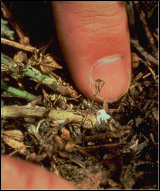Sclerotina Crown and Stem Rot in Alfalfa
Sclerotina Crown and Stem Rot
Symptoms
Crowns and lower stems become soft, mushy and discolored. Leaves and stems may yellow and die. White aerial mold growth may be produced in light brown, soft mushy stems. Hard black, small, round to irregular-shaped bodies (sclerotia) ranging from small to about the size of a BB pellet may be found on or embedded in lower stems and crowns. These black bodies have a white to silvery interior when cut. Patches of dead and dying plants appear as if they have been scalded.

Sclerotina (white area)
Cause
The causal agent is Sclerotinia trifoliorum. Symptoms are most common in early spring, especially in no-till fields, areas of high moisture, wet soils, rank growth, or any areas where poor air circulation occurs. Severe winter injury also increases crown and stem rot problems. Damage can be extensive to fall-seeded stands in the spring following seeding, especially if there is extended snow cover or if it is a no-till stand. When this disease is severe, the damage is sometimes mistakenly attributed to winter kill, because almost all the plants in a fall-seeded stand may be killed. You may need to send affected plants to a plant pathology identification lab to confirm existence of the disease.
IPM Techniques
- Examine plants in the field every two to four weeks from March 1 to May 15. Report severity of the disease according to the following rating scale:
0 = no affected plants
1= only 1 to 2% plants showing typical symptoms

Hard, black sclerotia
2 = 2 to 15% of plants affected
3 = more than 15% of plants affected.
- Spring planting greatly reduces Sclerotinia crown and stem rot.
- If using late summer and fall plantings then plantings should be made as early as possible so that seedlings are well established.
- Damage is most severe in fields established using minimum tillage.
- Use Sclerotia-free seeds when planting.
References and Additional Information
- IPM-1 Kentucky Alfalfa IPM Manual
- PPA-10d Kentucky Plant Disease Management Guide for Forage Legumes, P. Vincelli, Extension Plant Pathology, University of Kentucky
- ID-104 Managing Diseases of Alfalfa, P. Vincelli, Extension Plant Pathology, and G.D. Lacefield and J.C. Henning, Agronomy, University of Kentucky
- PPFS-AG-F-2 Risk Factors for Sclerotinia Crown and Stem Rot in Fall-Seeded Alfalfa. University of Kentucky
- Compendium of Alfalfa Diseases. 2nd ed. Stuteville, D.L. & D.C. Erwin, (eds.). 1990.


